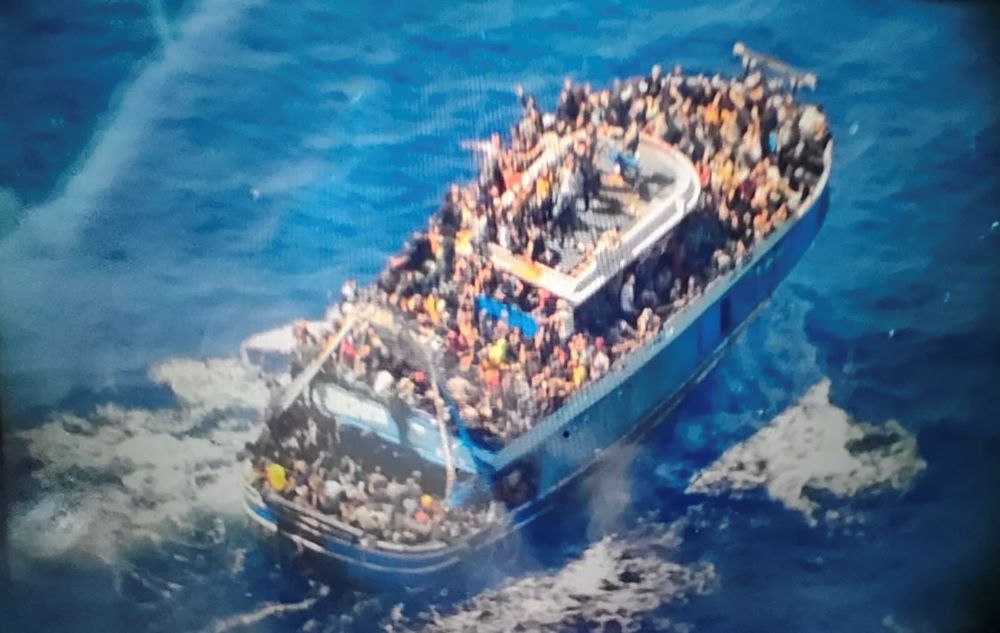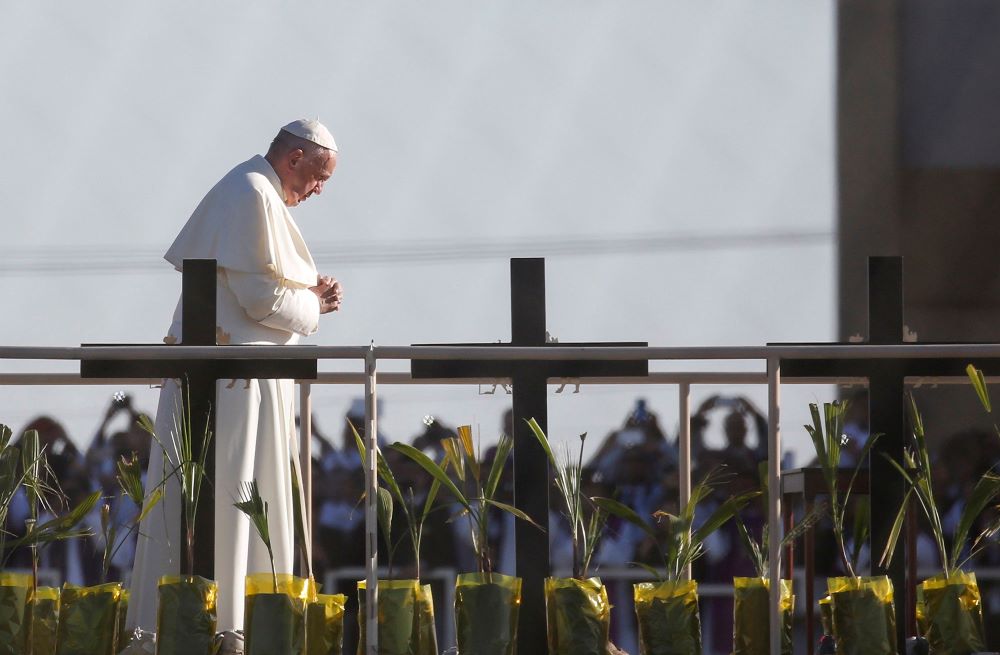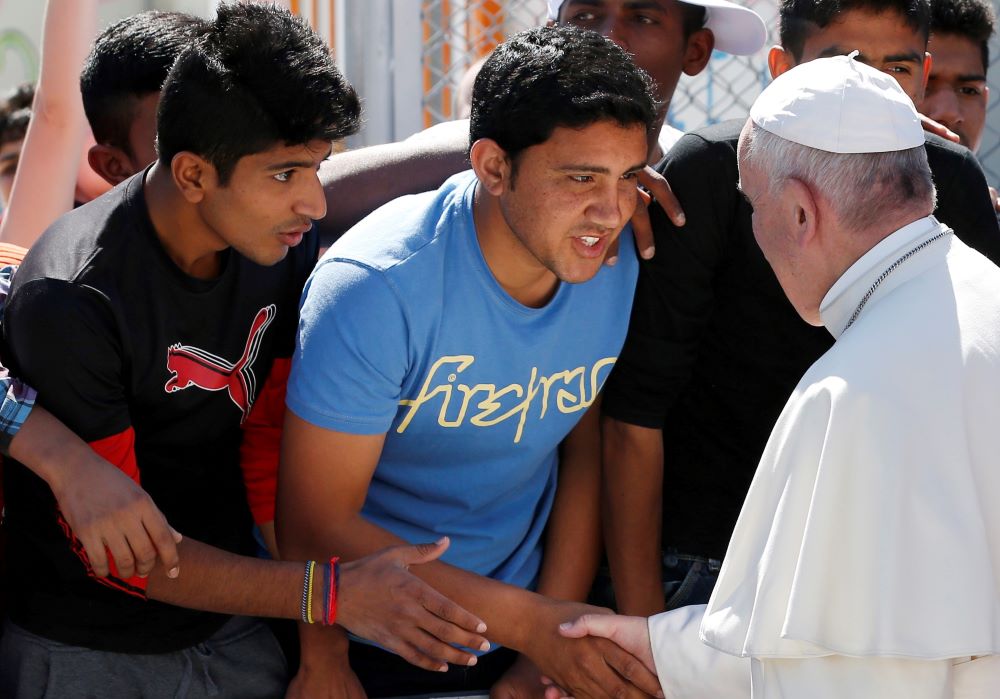
This undated handout image provided by Greece's coast guard shows scores of people on the Adrianba, a battered fishing boat that capsized and sank off southern Greece June 14. More than 600 people may have drowned in what officials say was the deadliest Mediterranean shipwreck in years. (AP/Hellenic Coast Guard)
On July 8, 2013, Pope Francis made his first trip outside Rome. Instead of traveling to a glamorous European capital or some other well-known destination, he chose to fly to a remote Italian island in the southern Mediterranean called Lampedusa. The island continues to be a place where boats with migrants land in their attempts to reach Europe.
He chose Lampedusa against the advice of some key advisers, who thought it was not worthy of his first trip and would not be covered by the press. Instead, it set the tone for his pontificate of reaching out to the "margins." On that day, he spoke of the "globalization of indifference" to the plight of migrants, a phrase that reverberates to this day.
In the 10 years since that visit, his other symbolic gestures have raised awareness about migrants and refugees and the global indifference to their plight. In Mexico, he stood at the U.S.-Mexico border and prayed for the thousands of migrants who had died attempting to reach the United States. At the height of the Syrian refugee crisis in 2016, he flew to the Greek island of Lesbos and brought several refugees to the Vatican.
He also has challenged world leaders on the subject. In 2014, he spoke to the European parliament and sternly warned them that the Mediterranean was becoming a "vast cemetery." He famously confronted then-presidential candidate Donald Trump in 2016, stating that anyone who builds walls and not bridges is "not Christian." More recently, the pope met with Viktor Orban, the president of Hungary, urging him to reconsider his nativist views.
Other than perhaps the issue of climate change, migration has been the central issue of the papacy of Pope Francis. But has the Holy Father's advocacy made a difference in how governments respond to global migration? The record is mixed — and incomplete.
Ten years after his Lampedusa visit, the world still sees record levels of migration, with 110 million people worldwide forcibly displaced, according to a June 13 UN refugee agency report. The powerful, industrialized nations — including the United States, Canada and the United Kingdom — are deploying deterrence strategies, even denying asylum protection to those who arrive on their shores. European nations, including Italy and Greece, continue to interdict migrants at sea and return them, while also reducing their commitment to rescue migrants at sea.

Pope Francis prays overlooking the U.S.-Mexico border before celebrating Mass in Ciudad Juarez, Mexico, Feb. 17, 2016. About 550 guests situated on a levee north of the Rio Grande in Texas took part in the Mass. (CNS/Nancy Wiechec)
Perhaps the most disturbing incident since the pope's Lampedusa visit has been the drowning of more than 600 migrants in the Mediterranean June 14, in which the Greek Coast Guard did little to rescue their sinking boat. It sadly confirmed the Holy Father's prediction of a "vast cemetery" in the Mediterranean and underscored the "globalization of indifference" he warned of in Lampedusa.
In his consistent defense of the migrant, the pope also has drawn dissent, including from Catholics who identify with the far right. For example, Steve Bannon, the former Trump adviser and a Catholic, has consistently attacked the pope on his stance on refugees and encouraged other Catholic leaders to do so.
Despite evidence that the main threat to Christianity in Europe is secularization, others have suggested that the pope's views on migration have paved the way for the Islamization of Europe, framing the refugee issue as a battle between Christianity and Islam.
The horror of more than 600 human beings, including women and children, dying preventable deaths in June may finally force the world's elected officials to sit up and listen. If they had only listened 10 years ago, the world might be in a different place.
Another myth spread by some opponents is that the pope supports "open borders," or does not believe in the sovereignty of nations. Again, this is inaccurate. The pope has reaffirmed the right of nations to control their borders, but has argued that it should not be done at the expense of human rights, stating that migrants are not "pawns" on the "chessboard of humanity."
Despite this opposition, the pope has not been deterred from defending migrants and refugees. In truth, over time his voice has made a difference, helping to soften migration policies and strengthen immigration advocates around the globe.

Pope Francis meets refugees at the Moria refugee camp on the island of Lesbos, Greece, in this April 16, 2016, file photo. (CNS/Paul Haring)
In fact, Europe has received more than a million refugees from Syria and nearly 7 million from Ukraine, with Hungary having received more than 1 million Ukrainians alone. Germany, Europe's biggest economy, continues to welcome immigrant workers from around the world, having added more than 1 million foreign-born laborers since 2015, many of whom are former Syrian refugees.
Despite the Trump era, the U.S. is rebuilding its refugee program and has accepted nearly 80,000 Afghans and more than 100,000 Ukrainians in the past two years. The U.S. also continues to lead the world in funding for refugees worldwide. The Biden administration's recent initiative to establish regional processing centers in Latin America to facilitate legal migration to the U.S. may, if properly implemented, serve as a model worldwide.
The migration issue is another example of the church favoring the poor over the rich, as she has done for centuries, and, in this case, the Global South against the Global North. The pope is simply following Catholic tradition and teaching by raising his voice in response to the many injustices and deaths witnessed every day — from the Mediterranean to the U.S. desert. He would be derelict in his duties if he were to remain silent.
Advertisement
From the beginning, the Holy Father's goal has been to educate Catholics and others globally on one of the central human rights issues of our time. In a time of economic uncertainty and the rise of nativist movements, he has faced stiff headwinds. It will take time to change hearts and minds.
However, the story of Pope Francis' influence on global migration policy has not been fully written. The horror of more than 600 human beings, including women and children, dying preventable deaths in June may finally force the world's elected officials to sit up and listen. If they had only listened 10 years ago, the world might be in a different place.
In Lampedusa, the Holy Father, reading the "signs of the times," appropriately positioned the church as the defender of those in search of safety and a better life — as the "mother to all." In the end, only history will truly judge how he has impacted this issue, both during his pontificate and in the future. One thing is for sure, however: He has planted the seeds in our global conscience in a way that, over time, will eventually bear fruit.







